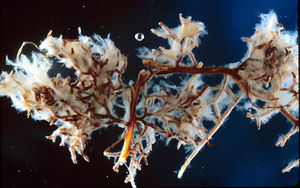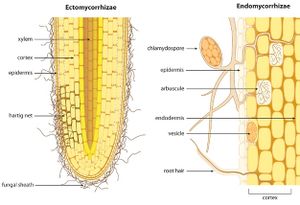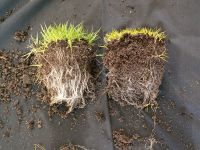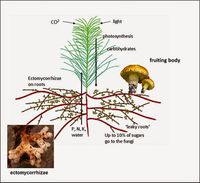Ectomycorrhizal Fungi: Difference between revisions
No edit summary |
No edit summary |
||
| Line 5: | Line 5: | ||
[[File:Ecto Vs. Endo.png|500px|thumb|right| Endomycorrhiza vs Ectomycorrhiza]] | [[File:Ecto Vs. Endo.png|500px|thumb|right| Endomycorrhiza vs Ectomycorrhiza]] | ||
==Structures== | ==Structures== | ||
[[File:Ecm diagram.jpg|thumb|Diagram of ectomycorrhizal fingal relationship (left). Photo from Nature Education Bonfante.]] | [[File:Ecm diagram.jpg|thumb|Diagram of ectomycorrhizal fingal relationship (left). Photo from Nature Education Bonfante.]] | ||
Revision as of 15:47, 30 March 2022

Ectomycorrhizal fungi (ECM) are a subgroup of mycorrhizae that evolved with the first land plants around 450 million years ago. They form symbiotic relationships with plant roots. Despite ectomycorrhizae forming on about 2% of plant species on earth, they perform some of the most environmentally and economically beneficial interactions. [1] ECM assist plants in nutrient uptake and prevent the uptake of toxic or harmful materials and pathogens.
They differ from the subgroup endomycorrhizae in that they do not penetrate the roots and are mainly found on the outside of the root system. The word Ectomycorrihiza stems from three Greek words: ἐκτός ektos, "outside"; μύκης mykes, "fungus"; and ῥίζα rhiza, "root".

Structures

Mantle
A layer encasing the outside of the root tip in either a loose gathering or tight alignment of hyphae. The presence of the mantle can sometimes hinder root hair growth if the root is secured tightly.
Hartig net
A network of hyphae strands that work around epidermal and cortical root cells, as they make their way through the cortex towards the middle of the root. [4]
Extraradical hyphae
A fine network of hyphae that extend outward from the encased root, filling the role of the suppressed root hairs. By spreading out into the surrounding soil, the hyphae can extract water and nutrients for transport back to the root.
Fruiting bodies
The most recognizable part of an ECM relationship is the fruiting body. These growths are usually easy to spot with the naked eye. The function of the fruiting body is sexual reproduction to spread the fungus to new hosts.
Symbiotic Relationship

In order to attract and form an ECM relationship, plants release metabolites, or small molecules, that encourage hyphae to grow in the direction of the plant root. [7] Flavonoids are one example of a metabolite exuded by plant roots. [8] Once the hyphae approach and penetrate the outer membrane of the root cap, the fungus can begin to infect the plant. In some cases, natural defenses may still resist the invasion by default for up to 21 days. [3]
Relationship in action
Once the fungus has infected the plant roots and the epidermal cells, the mantle can form. Upon initial colonization, increased polypeptide synthesis has been observed. [9] Arguably the most important function of mycorrhizal fungi as a whole is its propensity to aid in the uptake of nitrogen. [10] Used in chlorophyll, enzymes, and amino acids within the plant, nitrogen is required for most vital bodily processes. Partnerships with mycorrhizal fungi allow for plants to have a leg up on competitors who do not have the privilege of fungi assistance to draw in more nutrients for use.
Process of nutrient transport
Nutrients are absorbed from the surrounding soil and transported to the plant roots through the use of three components. The interfaces essentially describe the fairly obvious flow of nutrients.
1: Soil-fungus interface
2: Fungus-apoplast interface
3: Apoplast-root interface
Once nutrients have reached the fungus-apoplast interface, the fungus keeps some of the acquired nutrients to maintain its own homeostasis. Up to 86% of the host's nitrogen requirements can be provided by the fungus, while keeping around 15% of the plant's net primary productivity. [11]
Impacts
While Ectomycorrhiza play an important role when they are present, it is estimated that they only have formed relationships with around two percent of plant species. This is a small number, but when they are present they can influence and help establish around thirty percent of the soil bacteria mass. The ECM fungi are an important part in ecosystems such as Boreal forests. They relay on their partner organism (trees) just as much as the trees relies on them. They can both survive without the other, but together they can prosper and even survive where they could not if alone. When present they can account for 10-30% of the assimilated carbon the host plant synthesizes. ECM also break down inorganic substances with its special enzymes that the plant can not, making such substances biologically available for uptake.
Agriculture and Restoration

In agricultural and restoration efforts, trees are often planted with ECM from their native ranges. Without their respective symbiotic partners in the soil, some tree species can struggle with the uptake of nutrients needed to survive.
References
[1] Tedersoo, Leho; May, Tom W.; Smith, Matthew E. (2010). "Ectomycorrhizal lifestyle in fungi: global diversity, distribution, and evolution of phylogenetic lineages" (PDF). Mycorrhiza. 20 (4): 217–263. doi:10.1007/s00572-009-0274-x. PMID 20191371.
[2] Dighton, J. "Mycorrhizae." Encyclopedia of Microbiology (2009): 153-162.
[3] Smith, Sally E.; Read, David J. (26 July 2010). Mycorrhizal Symbiosis. Academic Press. ISBN 978-0-08-055934-6.
[4] Carlile, M.J. & Watkinson, S.C. (1994) The Fungi. Academic Press Ltd, London. pp 329 - 340.
[5] Díez, Jesús. "Invasion biology of Australian ectomycorrhizal fungi introduced with eucalypt plantations into the Iberian Peninsula" (PDF). Issues in Bioinvasion Science. 2005: 3–15. doi:10.1007/1-4020-3870-4_2.
[6] Dickie, Ian A.; et al. (2010). "Co‐invasion by Pinus and its mycorrhizal fungi". New Phytologist. 187 (2): 475–484. doi:10.1111/j.1469-8137.2010.03277.x. PMID 20456067.
[7] Egerton-Warburton, L. M.; et al. (2003). "Mycorrhizal fungi". Encyclopedia of Soils in the Environment.
[8] Martin, Francis; et al. (2001). "Developmental cross talking in the ectomycorrhizal symbiosis: signals and communication genes". New Phytologist. 151 (1): 145–154. doi:10.1046/j.1469-8137.2001.00169.x.
[9] Hilbert, Jean-Louis; Costa, Guy; Martin, Francis (1991). "Ectomycorrhizin synthesis and polypeptide changes during the early stage of eucalypt mycorrhiza development" (PDF). Plant Physiology. 97 (3): 977–984. doi:10.1104/pp.97.3.977.
[10] Chalot, Michel; Brun, Annick (1998). "Physiology of organic nitrogen acquisition by ectomycorrhizal fungi and ectomycorrhizas". FEMS Microbiology Reviews. 22 (1): 21–44. doi:10.1111/j.1574-6976.1998.tb00359.x.
[11] Peay, Kabir G.; et al. (2007). "A strong species–area relationship for eukaryotic soil microbes: island size matters for ectomycorrhizal fungi" (PDF). Ecology Letters. 10 (6): 470–480. doi:10.1111/j.1461-0248.2007.01035.x.
[12] Tedersoo, Leho, et al. “Ectomycorrhizal Lifestyle in Fungi: Global Diversity, Distribution, and Evolution of Phylogenetic Lineages.” SpringerLink, Springer-Verlag, 16 Sept. 2009, link.springer.com/article/10.1007/s00572-009-0274-x.
[13] Ruotsalainen, A. L., et al. “Mycorrhizal Colonisation .” SpringerLink, Springer Netherlands, 8 Mar. 2008, link.springer.com/article/10.1007/s10661-007-0152-y.
[14] The Role of Ectomycorrhiza in Boreal Forest Ecosystem, L. Qu, K. Makoto, D. S. Choi, A. M. Quoreshi, T. Koike